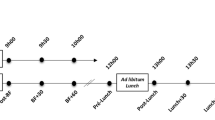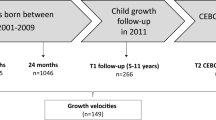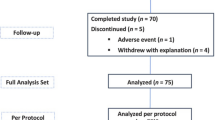Abstract
Objective:
To determine patterns of satiety responsiveness and its relationship to eating in the absence of hunger (EAH), in a cohort of adolescents. We also assessed whether sex, body mass index and duration of breastfeeding, during infancy, predicted satiety responsiveness and eating behavior at 16 years.
Methods:
Adolescents (n=576) from a longitudinal cohort, which began as an iron deficiency anemia preventive trial, participated in an unlimited breakfast after an overnight fast, and reported satiety response on a visual analog scale after the meal, followed by an EAH procedure. Height, weight and body composition were measured before breakfast. Latent profile analysis generated profiles that captured individual differences in satiety responsiveness. Multivariable regressions, adjusted for potential confounders, evaluated the association between: (1) satiety responsiveness and EAH, and (2) breastfeeding in infancy, satiety responsiveness and EAH in adolescence.
Results:
Participants were on average 16.7-year old, 48% female, 37% overweight/obese and 76% were breastfed as the sole source of milk for <6 months. We found three latent profiles of satiety responsiveness: 1: ‘responsive’ (49%); 2: ‘not responsive’ (41%); 3: ‘still hungry’ (10%). Participants in the ‘not responsive’ or ‘still hungry’ profile were more likely to eat during the EAH procedure (odds ratio (OR)=2.5, 95% confidence interval (CI)=1.8–3.6). Being breastfed for <6 months was related to higher odds of being in the ‘not responsive’ or ‘still hungry’ profile (OR=1.8, 95% CI=1.2–2.6) and EAH (OR=2.2, 95% CI=1.4–3.3). Satiety responsiveness was not influenced by sex and overweight/obesity.
Conclusion:
After an ad libitum meal, we found varied satiety responses, which related to EAH. Furthermore, shorter breastfeeding duration was associated with poorer satiety response and higher consumption during an EAH procedure. Understanding if breastfeeding influences the development of satiety responsiveness and eating behavior may be important in an era characterized by abundant calorie-dense foods and a plethora of environmental cues promoting consumption.
This is a preview of subscription content, access via your institution
Access options
Subscribe to this journal
Receive 12 print issues and online access
$259.00 per year
only $21.58 per issue
Buy this article
- Purchase on Springer Link
- Instant access to full article PDF
Prices may be subject to local taxes which are calculated during checkout

Similar content being viewed by others
References
Daniels SR, Jacobson MS, McCrindle BW, Eckel RH, Sanner BM . American Heart Association Childhood Obesity Research Summit Report. Circulation 2009; 119: e489–e517.
Mitchell NS, Catenacci VA, Wyatt HR, Hill JO . Obesity: overview of an epidemic. Psychiatr Clin North Am 2011; 34: 717–732.
Hill JO, Peters JC . Environmental contributions to the obesity epidemic. Science 1998; 280: 1371–1374.
Kral TV, Faith MS . Child eating patterns and weight regulation: a developmental behaviour genetics framework. Acta Paediatr Suppl 2007; 96: 29–34.
Monteiro CA, Levy RB, Claro RM, de Castro IR, Cannon G . Increasing consumption of ultra-processed foods and likely impact on human health: evidence from Brazil. Public Health Nutr 2011; 14: 5–13.
van Strien T, Herman CP, Verheijden MW . Eating style, overeating and weight gain. A prospective 2-year follow-up study in a representative Dutch sample. Appetite 2012; 59: 782–789.
Gahagan S . Development of eating behavior: biology and context. J Dev Behav Pediatr 2012; 33: 261–271.
Harrold JA, Dovey TM, Blundell JE, Halford JC . CNS regulation of appetite. Neuropharmacology 63: 3–17.
Bartok CJ, Ventura AK . Mechanisms underlying the association between breastfeeding and obesity. Int J Pediatr Obes 2009; 4: 196–204.
Birch LL, Fisher JO . Development of eating behaviors among children and adolescents. Pediatrics 1998; 101 (3 Pt 2): 539–549.
Niño RSG, Atalah E . Determinants of exclusive breastfeeding in health centers in Santiago, Chile. Rev Chil Pedriatr 2012; 83: 161–169.
Rios-Castillo I, Cerezo S, Corvalan C, Martinez M, Kain J . Risk factors during the prenatal period and the first year of life associated with overweight in 7-year-old low-income Chilean children. Maternal Child Nutr 2012. e-pub ahead of print 13 December 2012 doi:10.1111/mcn.12024.
Arenz S, Ruckerl R, Koletzko B, von Kries R . Breast-feeding and childhood obesity—a systematic review. Int J Obes Relat Metab Disord 2004; 28: 1247–1256.
Kramer MS, Matush L, Vanilovich I, Platt RW, Bogdanovich N, Sevkovskaya Z et al. A randomized breast-feeding promotion intervention did not reduce child obesity in Belarus. J Nutr 2009; 139: 417S–421SS.
Martin RM, Patel R, Kramer MS, Guthrie L, Vilchuck K, Bogdanovich N et al. Effects of promoting longer-term and exclusive breastfeeding on adiposity and insulin-like growth factor-I at age 11.5 years: a randomized trial. JAMA 2013; 309: 1005–1013.
Morley R, Lucas A . Randomized diet in the neonatal period and growth performance until 7.5-8 y of age in preterm children. Am J Clin Nutr 2000; 71: 822–828.
Corvalan C, Uauy R, Stein AD, Kain J, Martorell R . Effect of growth on cardiometabolic status at 4 y of age. Am J Clin Nutr 2009; 90: 547–555.
Anzman SL, Rollins BY, Birch LL . Parental influence on children's early eating environments and obesity risk: implications for prevention. Int J Obes (Lond) 2010; 34: 1116–1124.
Owen CG, Martin RM, Whincup PH, Smith GD, Cook DG . Effect of infant feeding on the risk of obesity across the life course: a quantitative review of published evidence. Pediatrics 2005; 115: 1367–1377.
Li R, Fein SB, Grummer-Strawn LM . Do infants fed from bottles lack self-regulation of milk intake compared with directly breastfed infants? Pediatrics 2010; 125: e1386–e1393.
Disantis KI, Collins BN, Fisher JO, Davey A . Do infants fed directly from the breast have improved appetite regulation and slower growth during early childhood compared with infants fed from a bottle? Int J Behav Nutr Phys Act 2011; 8: 89.
Li R, Fein SB, Grummer-Strawn LM . Do infants fed from bottles lack self-regulation of milk intake compared with directly breastfed infants? Pediatrics 2010; 125: e1386–e1393.
Jordan HA, Wieland WF, Zebley SP, Stellar E, Stunkard AJ . Direct measurement of food intake in man: a method for the objective study of eating behavior. Psychomsom Med 1966; XXVIII: 836–842.
Flint A, Raben A, Blundell JE, Astrup A . Reproducibility, power and validity of visual analogue scales in assessment of appetite sensations in single test meal studies. Int J Obes Relat Metab Disord 2000; 24: 38–48.
Parker BA, Sturm K, MacIntosh CG, Feinle C, Horowitz M, Chapman IM . Relation between food intake and visual analogue scale ratings of appetite and other sensations in healthy older and young subjects. Eur J Clin Nutr 2004; 58: 212–218.
Drapeau V, King N, Hetherington M, Doucet E, Blundell J, Tremblay A . Appetite sensations and satiety quotient: predictors of energy intake and weight loss. Appetite 2007; 48: 159–166.
Wang GJ, Volkow ND, Telang F, Jayne M, Ma J, Rao M et al. Exposure to appetitive food stimuli markedly activates the human brain. Neuroimage 2004; 21: 1790–1797.
Fisher JO, Birch LL . Restricting access to palatable foods affects children's behavioral response, food selection, and intake. Am J Clin Nutr 1999; 69: 1264–1272.
Wardle J, Guthrie CA, Sanderson S, Rapoport L . Development of the children's eating behaviour questionnaire. J Child Psychol Psychiatry 2001; 42: 963–970.
Fisher JO, Birch LL . Eating in the absence of hunger and overweight in girls from 5 to 7 y of age. Am J Clin Nutr 2002; 76: 226–231.
Birch LL, Fisher JO, Davison KK . Learning to overeat: maternal use of restrictive feeding practices promotes girls' eating in the absence of hunger. Am J Clin Nutr 2003; 78: 215–220.
Shomaker LB, Tanofsky-Kraff M, Zocca JM, Courville A, Kozlosky M, Columbo KM et al. Eating in the absence of hunger in adolescents: intake after a large-array meal compared with that after a standardized meal. Am J Clin Nutr 2010; 92: 697–703.
Kral TV, Moore RH, Stunkard AJ, Berkowitz RI, Stettler N, Stallings VA et al. Adolescent eating in the absence of hunger and relation to discretionary calorie allowance. J Am Diet Assoc 2010; 110: 1896–1900.
Lozoff B, De Andraca I, Castillo M, Smith JB, Walter T, Pino P . Behavioral and developmental effects of preventing iron-deficiency anemia in healthy full-term infants. Pediatrics 2003; 112: 846–854.
Walter T, Pino P, Pizarro F, Lozoff B . Prevention of iron-deficiency anemia: comparison of high- and low-iron formulas in term healthy infants after six months of life. J Pediatr 1998; 132: 635–640.
Lanza ST, Collins LM, Lemmon DR, Schafer JL . PROC LCA: A SAS Procedure for Latent Class Analysis. Struct Equ Modeling 2007; 14: 671–694.
Roesch SC, Villodas M, Villodas F . Latent class/profile analysis in maltreatment research: a commentary on Nooner et al., Pears et al., and looking beyond. Child Abuse Negl 2010; 34: 155–160.
Muthen B, Muthen LK . Integrating person-centered and variable-centered analyses: growth mixture modeling with latent trajectory classes. Alcohol Clin Exp Res 2000; 24: 882–891.
Akaike H . Factor-analysis and AIC. Psychometrika 1987; 52: 317–332.
Schwarz G . Estimating dimension of a model. Ann Stat 1978; 6: 461–464.
Sclove SL . Application of a model-selection criteria to some problems in multivariate-analysis. Pshychometrika 1987; 52: 333–343.
Celeux G, Soromenho G . An enthropy criterion for assessing the number of clusters in a mixture model. J Classif 1996; 13: 195–212.
Moens E, Braet C . Predictors of disinhibited eating in children with and without overweight. Behav Res Ther 2007; 45: 1357–1368.
Disantis KI, Collins BN, Fisher JO, Davey A . Do infants fed directly from the breast have improved appetite regulation and slower growth during early childhood compared with infants fed from a bottle? Int J Behav Nutr Phys Act 2011; 8: 89.
Acknowledgements
We thank all participants and their families for their trust and ongoing participation. We also thank the research and health professionals who have worked on the different aspects of the longitudinal project over the last 21 years. This study was supported by grants from the National Institutes of Health, Heart, Lung, and Blood Institute (HL088530, PI: Gahagan), the National Institute of Child Health and Human Development (HD14122, PI: Lozoff, and HD33487, PI: Lozoff and Gahagan) and the National Center of Minority Health and Health Disparities supported the participation of Vanessa Hoyos (Grant # 5-T32-MD-0001425-15, administered by the Center for Human Growth and Development of the University of Michigan).
Author information
Authors and Affiliations
Corresponding author
Ethics declarations
Competing interests
The authors declare no conflict of interest.
Rights and permissions
About this article
Cite this article
Reyes, M., Hoyos, V., Martinez, S. et al. Satiety responsiveness and eating behavior among Chilean adolescents and the role of breastfeeding. Int J Obes 38, 552–557 (2014). https://doi.org/10.1038/ijo.2013.191
Received:
Revised:
Accepted:
Published:
Issue Date:
DOI: https://doi.org/10.1038/ijo.2013.191
Keywords
This article is cited by
-
Eating in the Absence of Hunger and Obesity Among Adolescents in Santiago, Chile
Journal of Community Health (2019)
-
GOCS cohort: children's eating behavior scores and BMI
European Journal of Clinical Nutrition (2016)
-
Does Breastfeeding Protect Against Childhood Obesity? Moving Beyond Observational Evidence
Current Obesity Reports (2015)



